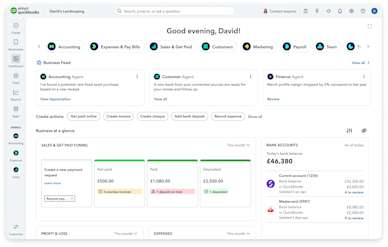
Cloud accounting
Soon you’ll be able to put Intuit AI agents to work for you
Simple, smart accounting software - no commitment, cancel anytime

TAX AND PENSIONS
Growing your business is always exciting. It’s a sign of success and it can open up some truly incredible opportunities. But it also comes with responsibilities. One of the biggest of these is Value Added Tax (VAT). Understanding VAT and what it means for your business is crucial. This is more true than ever with significant changes to the tax system on the horizon, such as the need to adopt Making Tax Digital (MTD) software.
In this article, we’ll explain everything you need to know about VAT, from what it is and how MTD will impact VAT reporting, to how to register for VAT online.
VAT is a form of indirect tax levied on consumption.
Unlike income tax, which is levied on how much an individual makes, VAT is levied on what they consume.
And unlike direct tax, which is paid straight to the government, VAT is added on at the point of sale.
Businesses include the cost of VAT when they sell a good or a service. They then add up how much they charged and send the total to HMRC. The government can change the VAT rate (such as the reduction for hospitality due to the coronavirus pandemic) but, for the standard VAT rate, it has not done so since 2011, when the rate was increased to 20%.
VAT covers things such as:
sales of goods and services
hire or loan of goods
exchanges
sale of business assets
commissions
However, not all goods or services are taxed at the standard rate (currently 20%) . Some products, such as children’s clothing, are taxed at 0% VAT. There are some exempt items, such as services related to PE and sports activities, and even lottery tickets.
This is because, as an indirect tax, VAT hits those with less money harder than those with more. To mitigate this, the government charges VAT, but at 0% or at a reduced rate (5%). Utilities fall under this reduced VAT rate as they’re considered ‘necessities’.
Now we know what VAT is, it’s time to explore what it means for you as a business owner. All businesses above a certain size must register for VAT, and doing so can bring both advantages and disadvantages.
All businesses above a certain size must register for VAT, and doing so can bring both advantages and disadvantages.
Businesses must register for VAT if they have turned over £85,000 or more in the last twelve months, or if they are likely to have a turnover more than that amount in the coming year.
Note: It is crucial that you register for VAT as soon as possible once you hit the threshold. If you do not, and HMRC finds out, you could be liable to pay a hefty fine and face penalties.
One major advantage that being VAT-registered brings is prestige. You sound like a ‘proper’ business, and customers, clients and competitors will take note.
It also signals your success. Some businesses register for VAT even if they are below the threshold as it makes them look more professional.
On top of this, registering for VAT also lets you recover VAT costs you incurred during startup. As long as you have records showing how much VAT you paid on goods and services, you can reclaim it from HMRC - and pump the money you get back straight into growing your business. Please note that there is a time limit for backdating claims.
The main downsides to registering for VAT is you have to submit quarterly returns to HMRC and keep digital records.
The majority of businesses submit quarterly VAT returns, but there are options to submit monthly or annual VAT returns. However, businesses must fit into certain criteria and apply to HMRC, which then needs to approve the change of frequency.
You need to keep records for your business, and keeping them digital is easier and more convenient.
Rather than an inconvenience, though, you should see this as an opportunity to keep a closer eye on your finances throughout the year instead of waiting till it’s time to pay your taxes. Software like QuickBooks can also make this easier, ensuring you have everything you need to submit and send full, accurate returns.
Thankfully, the process of registering for VAT online is quite simple. You log in to HMRC’s page with your Government Gateway ID and follow the steps outlined there. You fill out your application as prompted, and you can continually check its progress online until you hear back. HMRC usually processes applications in around a month, though it can take longer.
If you don’t have a Government Gateway ID…
go to the HMRC website to register
click ‘create sign in details’
enter your details as prompted
Once you’ve created your ID, you’ll be able to register for VAT online by the usual process.
If you really can’t register online, don’t panic. It takes longer, but there is another route to getting VAT-registered: you can register by post with a VAT1 paper form. See the government’s page for more details on how to do this.
Make sure you have the following documents handy when you go to register:
business contact details
bank account
unique Tax Reference number (if you’re an incorporated business, like a limited company, this will be your business UTR. If you’re a sole trader, then it is your Self-Assessment UTR)
details of turnover and nature of business
Once you’ve registered, you’ll be set up with a VAT online account. You’ll be sent a VAT certificate to that account within 30 days. That certificate will confirm your VAT number and tell you when you need to submit your first return and payment.
From then on, you just submit a return every quarter and pay what you owe to HMRC.
Remember to display your VAT number on your website, sales invoices and any other material shared with your clients.
Since April 2019, the government has begun to make major changes to the VAT system. Under Making Tax Digital (MTD), all returns must be handled digitally. The first phase of the scheme only covered businesses who had a turnover more than £85,000. But, from April 2022, all VAT-registered businesses must comply with MTD rules.
Under the new rules, VAT-registered businesses must use ‘functional compatible software’ to submit their returns directly to HMRC.
If you’re just looking up how to register for VAT online now, you will most likely be required to use MTD to fill out your first VAT report. This means you will not be able to enter your information manually via HMRC’s website.
Note: If you’re thinking of registering for VAT now, you should get to grips with MTD as soon as possible. The deadline is fast approaching and there are penalties for noncompliance. QuickBooks can help with this, as our software can make switching to MTD as easy as ticking the right box.
VAT is, for better or worse, a major part of the UK tax system, and all businesses who turn over more than £85,000 a year must register for it. Registering is simple online and doing so can be a sign that your business has entered the big leagues.
Software like QuickBooks can help you deal with the new responsibilities being VAT-registered brings - and can also make the switch to MTD as smooth as possible. It also offers free support from real people rather than chatbots, seven days a week, as well as an included error-checker, meaning you won’t be caught out with any mistakes in your accounting.
If you’re approaching the threshold, then the best thing you can do is register for VAT as soon as possible.
Ready to register for VAT? We have all the VAT information you need - and more - to get your business sorted.
Subscribe to get our latest insights, promotions, and product releases straight to your inbox.
9.00am - 5.30pm Monday - Thursday
9.00am - 4.30pm Friday